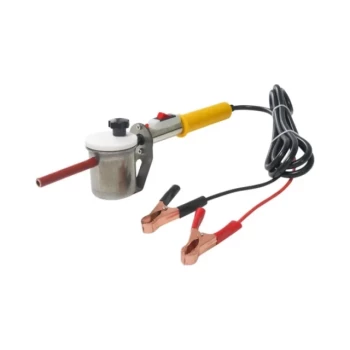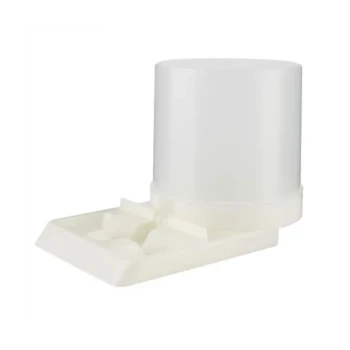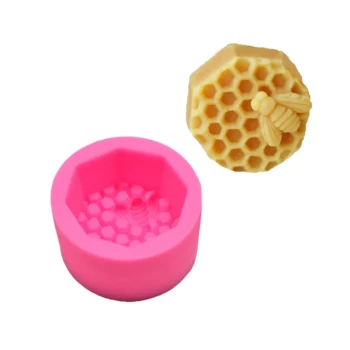For treating Varroa mites, the two most popular and approved methods for applying oxalic acid are the dribble method and the vaporization method. The dribble method involves trickling a liquid solution of oxalic acid and sugar water directly onto the bees clustered between the frames. In contrast, the vaporization method uses a specialized heating tool to turn oxalic acid crystals into a vapor that permeates the entire hive.
Choosing between oxalic acid application methods is a core decision in Varroa mite management. The choice is not about which is "better," but which is more appropriate for your specific goals, balancing treatment effectiveness, bee health, cost, and your own safety.
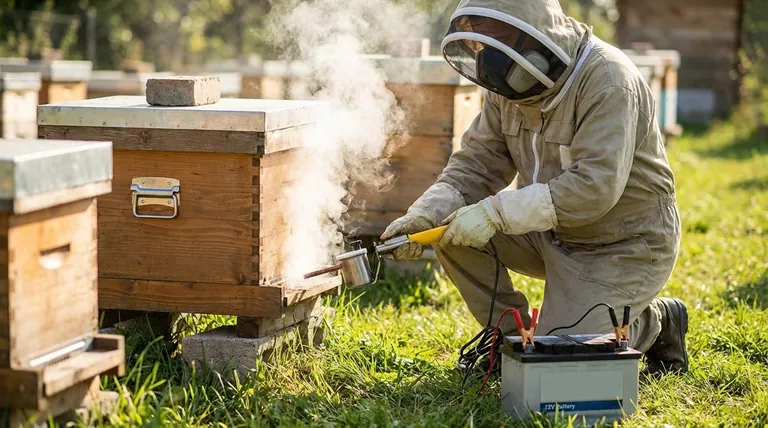
The Dribble Method: A Direct Application
The dribble method is a low-cost, straightforward technique that applies the treatment directly to the bees.
How It Works
The treatment solution is created by mixing oxalic acid dihydrate crystals with a warm 1:1 sugar-water solution. The sugar encourages the bees to consume and share the solution, helping to distribute it throughout the cluster.
The Application Process
Using a large syringe, the beekeeper applies a slow, steady stream or "dribble" of the solution into the seams between frames, directly onto the clustered bees.
The total dose is critical and should not exceed 50 ml per colony. Application must be precise to avoid overdosing the bees.
Key Considerations
This method is harshest on the bees' exoskeletons (cuticles) and digestive systems. For this reason, it is recommended for a single treatment during a broodless period, typically in late fall or early winter. Repeated applications can cause significant harm to the colony.
The Vaporization Method: A Hive-Wide Treatment
Vaporization, also known as sublimation, treats the entire hive environment rather than just the bees themselves.
How It Works
This method uses a specialized tool—an oxalic acid vaporizer—to heat the acid crystals. The heat causes the crystals to sublimate, turning directly from a solid into a gas.
This vapor fills the hive cavity and then re-crystalizes as it cools, leaving a coating of microscopic, spiky oxalic acid crystals on all surfaces, including the bees and combs.
The Mechanism of Action
Varroa mites are killed on contact with these fine crystals. The goal is not to coat the bees directly but to saturate the hive atmosphere, ensuring mites on any bee will be exposed to the treatment.
Key Considerations
Vaporization is generally considered less stressful on adult bees than the dribble method, allowing for multiple treatments if necessary to target mites emerging with new brood. This method is also significantly faster, especially for those managing multiple hives.
Understanding the Trade-offs
Neither method is universally superior; each comes with distinct advantages and disadvantages.
Impact on Bee Health
The dribble method is harsher on individual bees and should be used sparingly. Its direct application can damage the bees' cuticles.
Vaporization is gentler on the bees, making it a better choice if you anticipate needing follow-up treatments during a brood cycle.
Equipment and Cost
Dribbling requires only a syringe and basic mixing supplies, making it extremely low-cost and accessible for beginners.
Vaporization requires a specialized vaporizer wand, which represents a higher initial investment.
Speed and Scalability
For beekeepers with only a few hives, the time difference is negligible. However, vaporization is far more efficient for larger apiaries. Treating a hive via vaporization can be done quickly from the entrance without fully opening the brood box.
Beekeeper Safety
This is a critical distinction. The acidic solution used in the dribble method can cause chemical burns, requiring gloves and eye protection.
The vapor produced during sublimation is highly corrosive and damaging to the human respiratory system. A properly fitted respirator mask is absolutely non-negotiable when vaporizing, alongside gloves and safety glasses.
Making the Right Choice for Your Apiary
Your decision should be guided by the number of hives you manage, your budget, and how you prioritize bee health versus operational efficiency.
- If your primary focus is low cost and you have few hives: The dribble method is a simple, effective starting point for a single, broodless treatment.
- If your primary focus is efficiency for treating multiple hives: Vaporization is significantly faster, more scalable, and better suited for larger operations.
- If your primary focus is minimizing stress on your bees: Vaporization is generally considered gentler, allowing for more flexible treatment schedules if needed.
Understanding these distinct approaches empowers you to select the most effective and responsible mite control strategy for the long-term health of your colonies.
Summary Table:
| Method | Key Feature | Best For | Key Consideration |
|---|---|---|---|
| Dribble | Direct liquid application | Low-cost, small-scale beekeepers | Harsher on bees; single treatment recommended |
| Vaporization | Hive-wide vapor treatment | Larger apiaries, gentler on bees | Requires specialized equipment and respirator |
Need the Right Equipment for Your Varroa Mite Treatment Strategy?
Whether you're a commercial apiary or a beekeeping equipment distributor, choosing the correct application method is crucial for effective mite control and colony health. HONESTBEE supplies professional-grade beekeeping supplies and equipment, including reliable oxalic acid vaporizers and application tools, through our wholesale-focused operations.
We help you protect your investment by providing durable, effective solutions tailored for commercial-scale beekeeping. Contact us today via our [#ContactForm] to discuss your needs and get a quote on the equipment that will keep your colonies thriving.
Visual Guide
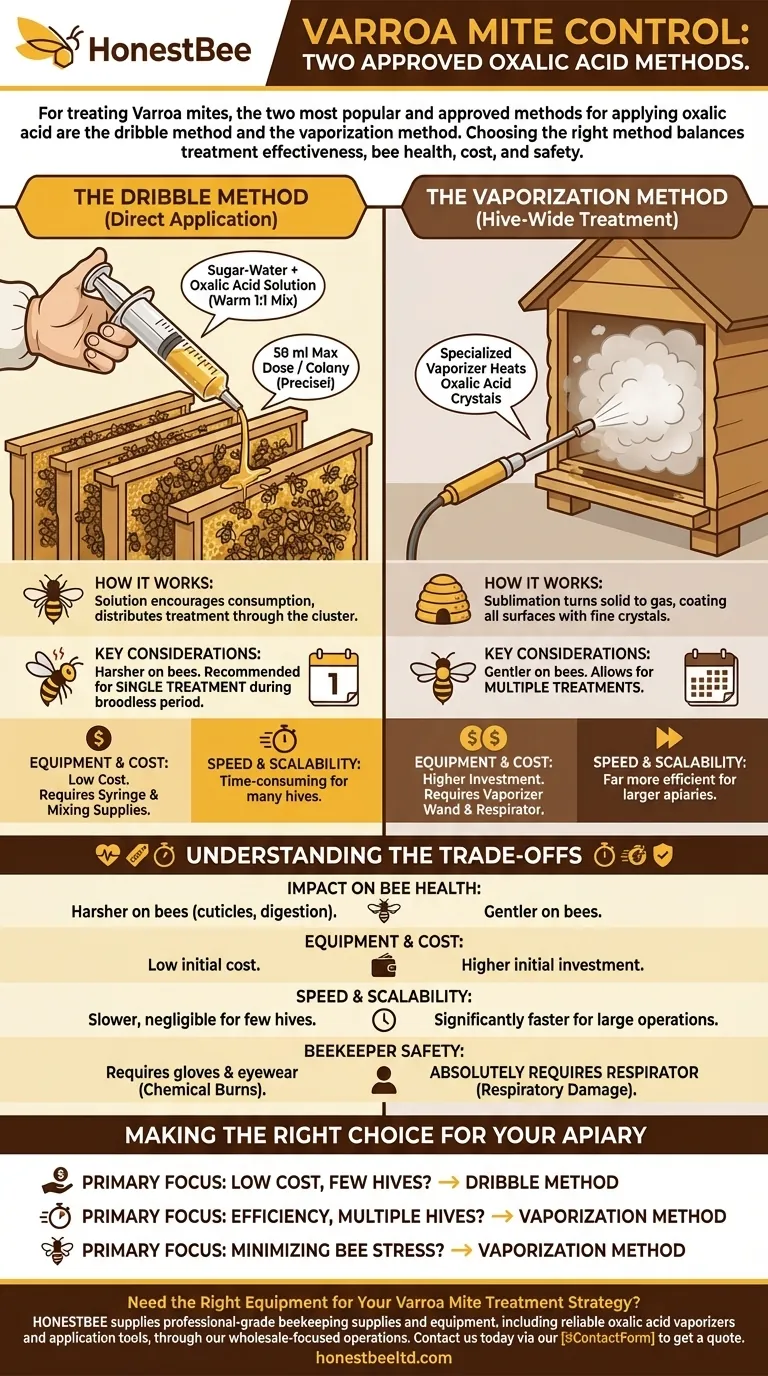
Related Products
- 12V Bee Mite Removal Evaporator Oxalic Acid Vaporizer for Bee Fumigation Treatment 180W Atomization
- Adjustable Formic and Acetic Acid Dispenser for Bee Mite Treatment
- Professional Bamboo Queen Isolation Cage
- Black Plastic Beetle Barn Hive Beetle Trap for Beehives
- Plastic Queen Bee Excluder for Bee Hive Wholesale
People Also Ask
- What is the role of oxalic acid in plants? A Key to Plant Defense and Internal Regulation
- What should be done after applying the vapor? A Step-by-Step Guide to Sealing Your Hive
- Why is oxalic acid not used in summer? Timing is critical for effective Varroa mite control.
- What are the supposed benefits of fogging oxalic acid over the dribble method? Speed, Coverage, and Bee Safety
- When is the best time to perform Oxalic Acid Vaporization? Maximize Mite Control for Healthy Hives
